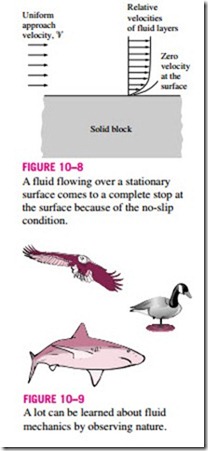■ HISTORY OF FLUID MECHANICS
Nature is like an exhibit hall for the applications of fluid mechanics, and we can learn a lot about the fundamentals of fluid mechanics and be inspired by carefully observing nature (Fig. 10–9). The development of fluid mechanics started in ancient times with the need to build irrigation systems and to design better ships with oars. The earliest contribution to the field was made by Archimedes (285–212 B.C.) who formulated the principles of buoyancy of submerged bodies and flotation, and applied those principles to determine the gold content of the crown of King Hiero I. At about the same time, the Roman engineers built an extensive network of fresh-water supply. There was no significant development in fluid mechanics through the Middle Ages until Leonardo da Vinci (1459–1519) conducted several experiments and derived the conservation of mass equation for one-dimensional steady flow.
The development of fluid mechanics continued along two different paths: on one, the mathematicians and physicists developed the theory and applied it to “idealized” problems that did not have much practical value. On the other path, engineers developed empirical equations that could be used in the design of fluid systems in a limited range. The lack of communication be- tween these two groups hindered the development of fluid mechanics for a long time. The development of the laws of motion by Isaac Newton (1649–1727) and the linear law of viscosity for the so-called Newtonian flu- ids set the stage for advances in fluid mechanics. Applying these laws to a fluid element, Leonhard Euler (1707–1783) obtained the differential equations for fluid motion in 1755. Daniel Bernoulli (1700–1782) developed the energy equation for incompressible flow in 1738. Lord Rayleigh (1849–1919) developed the powerful dimensional analysis technique. Osborn Reynolds (1849–1912) conducted extensive experiments with pipe flow and in 1883 came up with the dimensionless number that bears his name.
The general equations of fluid motion that include the effects of fluid friction, known as the Navier–Stokes equations, were developed by Claude Louis Marie Navier (1785–1836) in 1827 and independently by George Gabriel Stokes (1819–1903) in 1845. These equations were of little use at the time because they were too difficult to solve. Then in a pioneering paper in 1904, Ludwig Prandtl (1875–1953) showed that fluid flows can be divided into a layer near the walls, called the boundary layer, where the friction effects are significant and an outer layer where such effects are negligible, thus the Euler and Bernoulli equations are applicable. Theodore von Karman (1889–1963) and Sir Geoffrey I. Taylor (1886–1975) also contributed greatly to the development of fluid mechanics in the twentieth century. The avail- ability of high-speed computers in the last decades and the development of numerical methods have made it possible to solve a variety of real-world fluids problems and to conduct design and optimization studies through numerical simulation.
